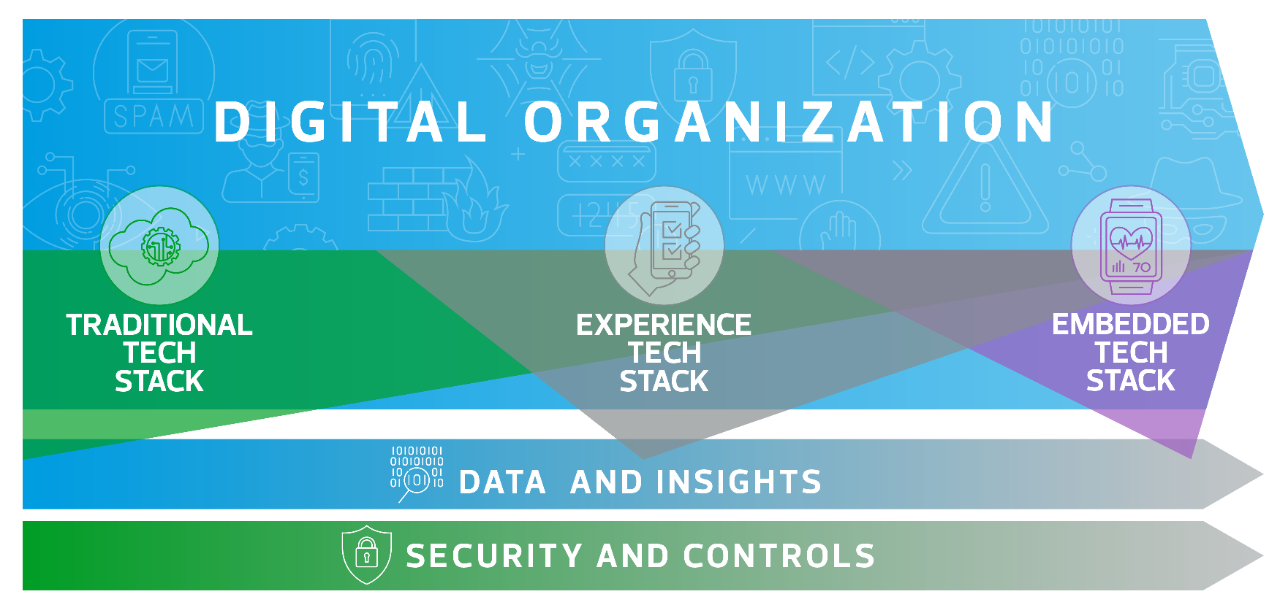Traditional tech stack
This phase is what organizations typically focus on when implementing digital transformation initiatives. Common technology solutions and applications that are considered and adopted at this step include ERP and CRM, as well as financial systems and Microsoft Office 365 applications. While these solutions may have been leading transformation efforts in the past, they have generally become expected for leading middle market businesses. Current transformation initiatives in the traditional tech stack include process automation, system integrations, data and optimization of core systems with new features and intelligence.
Experience tech stack
Enhancing the human experience is more important now than ever before, and this level of the road map focuses on the technology that makes your processes more engaging for customers and employees, and even for investors, shareholders and board members—anyone that interacts with your business. Common examples of solutions at this stage include your website, client and customer portals, or workflow applications like ServiceNow.
For example, elevating the customer experience is more important now than ever before, and company stakeholders generally understand the critical role technology can play. In a recent report by RSM and Corporate Board Member, nearly two-thirds of surveyed middle market board members (65%) listed improved customer experience as an objective that relies on leveraging new technology—the top result.
Embedded tech stack
As technology evolves, several applications and opportunities for automation are available to embed into products, services and processes. For example, building technology in your specific product to track the durability or efficiency and sharing that information with customers via a product-specific mobile application. These tools represent an evolution, as more areas of the business are now getting involved with automation, from operations to manufacturing and product design.
The more basic, foundational technology is located on the left side of the continuum and marketing and HR technology become involved as you move to the middle. When you move to the right, design and production become more engaged in innovation, helping you implement an enterprise approach to becoming digital. The combination of the traditional, experience and embedded tech stacks help to triangulate the direction and priorities of a digital organization.
However, there are two critical, additional elements that establish the foundation of the digital organization road map:
Data and insights
Companies produce immense amounts of data, and by becoming a fully digital organization, you can use that information to learn and make better decisions. Your data can help you understand how you are doing operationally (traditional), what people think of your business (experience) and how your products are performing (embedded). Building a true learning system should be the goal— getting there is not an easy task and requires a comprehensive data strategy.
Security and controls
As with any new technology investment, you need to ensure that you have the right controls and security technologies in place upfront. This will become more important with experience and embedded technology and any emerging innovation beyond that phase where protections may not be as mature as with traditional technology. Security should not be an afterthought and should be considered in the design of any transformation program.
Innovation and the digital journey are no longer just about the IT and marketing functions, and a true digital organization strategy may require a change in approach for many companies. It involves more teams, more processes and more people, but a successful program will add more capabilities and strengthen the business as a whole as you continue to evolve and integrate innovation on a broader scale.
“Technology has become so pervasive and companies need to find a way to embrace the process improvements it can provide across the organization,” said Kracunas. “With this framework in place, companies can ensure that they remain agile and innovative and position themselves as leaders within their respective industries.”
Taking advantage of digital technology creates excitement around the organization and, of course, it will come with associated challenges. But the companies that are idle as new solutions become available and realistic for the middle market will likely fall behind competitors. Becoming a truly digital organization is more than just automation, it’s about embracing innovation across the business instead of in a few select areas to create a sustainable, evolving, digital-friendly and profitable organization. Ultimately, the goal is to develop an organization that can mature to support more effective processes and actionable insights while making your business more resilient to changes in the marketplace.


